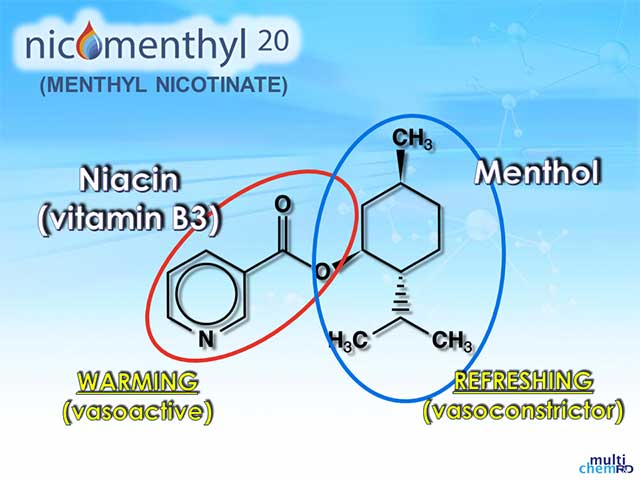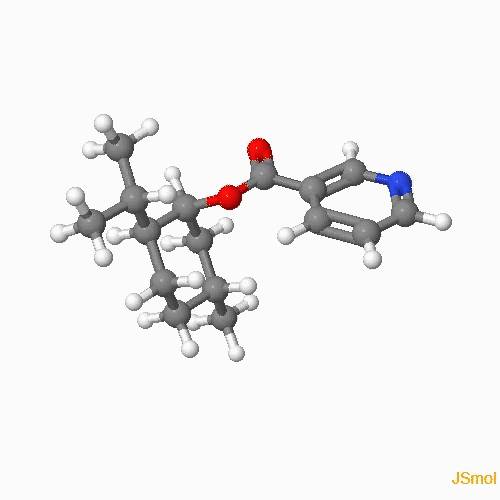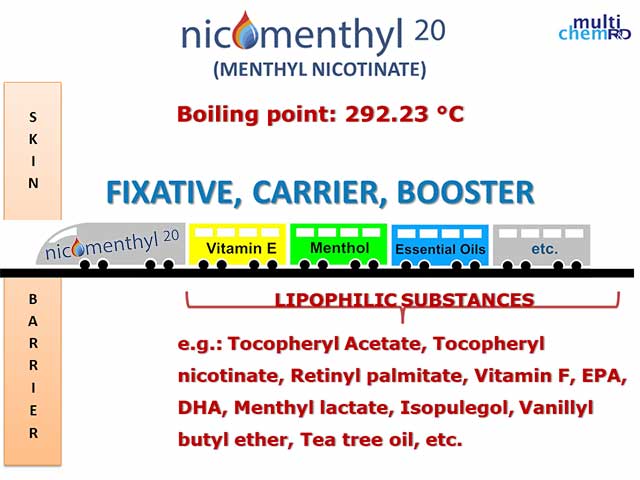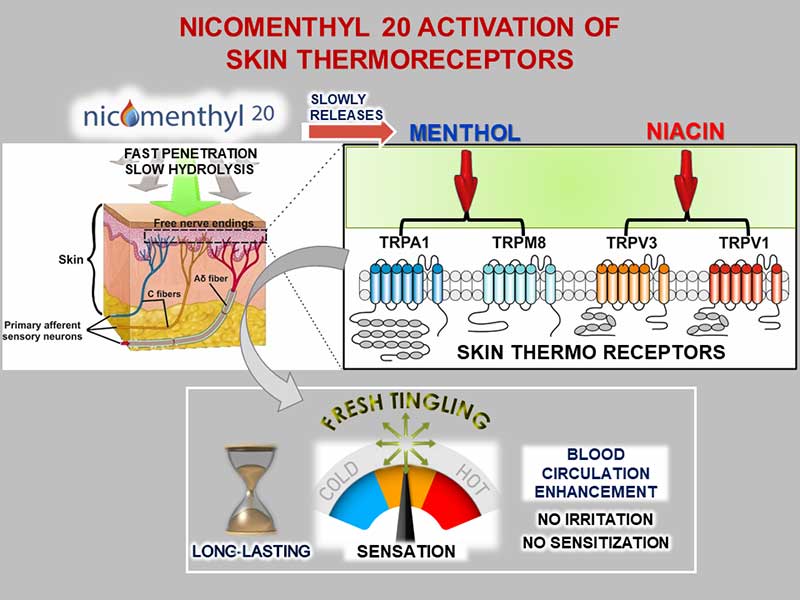MENTHYL NICOTINATE - The Multifunctional Sensorial Active
NICOMENTHYL® 20 is composed of pure MENTHYL NICOTINATE, with no residues of other nicotinates, obtained through a new and proprietary industrial synthesis process, developed over 20 years of research by Dr. Gabriele Segalla at Multichem R&D Laboratories, in Milan, Italy.
NICOMENTHYL 20 represents a new and revolutionary substance for cosmetic use that can significantly activate the cutaneous microcirculation without causing bothersome hyperemia or irritations, on the contrary it generates a pleasant hot-cold sensation in the area of application.
It is derived from the chemical reaction (esterification) of two natural components:
- Menthol, obtained from mint essential oil, has a refreshing and soothing effect on the skin.
- Nicotinic acid, also known by the names of Niacin or Vitamin B3 or Vitamin PP (Pellagra-Preventing), is used by the organism for forming coenzymes (NAD and NADP) that are essential for energy metabolism. These coenzymes take part in over 500 enzymatic reactions within the organism. Nicotinic acid helps break down and assimilate proteins, fats and glucosides. It plays a fundamental role in the formation of erythrocytes, in optimizing blood circulation and in providing oxygen to the cells. Its properties are used in topical applications for improving the barrier effect, oxygenating and nourishing the skin, accelerating cellular differentiation and cicatrization, as well as for its anti-inflammatory and detoxifying effects.

The molecule of Nicomenthyl 20 is composed of a “niacinic” part (derived from Niacin or Nicotinic Acid) and a “menthylic” part (derived from Menthol). The niacinic part tends to produce a warming vasodilating effect, while the menthylic part a fresh vasoconstricting effect. Thus, the application of a cosmetic product containing Nicomenthyl 20 on the skin results in an efficient activation of the cutaneous microcirculation and a simultaneous pleasant and persisting sensorial hot/cold effect or cool tingling.
FUNCTIONS
Multifunctional sensorial bioactive, activator of the cutaneous microcirculation, particularly indicated for:
- Cellulite treatment
- Hair loss prevention treatment
- Anti-age formulations (inhibits the slowdown of cutaneous microcirculation associated with ageing or slackening of the tissues)
- Oral care products and treatments
- Sport massage products
- Refreshing products for feet and legs
- Intimate hygiene products
- Lip plumping cosmetic treatments
- Spa treatment products
- Deodorant/antiperspirants
- Pre/after shave products
- Body lotions
ORIGIN
Obtained by a synthesis process from natural components
INCI (CTFA)
Menthyl Nicotinate.
COSMETIC FORMULATIONS
Liposoluble (add to oily phase). Can be processed either hot or cold (thermostable).
The sensorial effect is increased in water-based formulations, such as O/W emulsions, hydro-alcoholic lotions, water-based gels, etc.
Being a polar molecule, NICOMENTHYL 20, supported by appropriate thickening agents, has self-emulsifying properties, which allow formation of stable micro-emulsions.
RECOMMENDED USAGE
in Face Products: 0.5 – 1%
in Body Products: 0.5 – 3%
in Special Products: 5%
SAFETY TESTS
The following assessment tests were conducted on NICOMENTHYL 20: in vitro cutaneous irritation testing on 3D reconstructed human epidermis and vaginal tolerability testing on reconstructed vaginal epithelium; in vitro model testing to predict skin sensitization through assessment of the stimulating potential on the immune cellular response mediated by monocyte/macrophage cells; in vitro assessment of the ocular irritancy potential through cytotoxicity assay Neutral Red Uptake on cell culture and Het Cam testing on fertilized chicken eggs.
All tests have confirmed the absence of irritative and/or sensitizing effects. An evaluation of the genotoxic potential of NICOMENTHYL 20 through the Ames test did not show any evidence of mutagenicity.
IN VIVO EFFICACY TESTS
Doppler Laser Blood-flow Velocity Meter on twenty volunteers of both sexes (9 males, 11 females), with an average age of 41.2 years, with a cosmetic cream containing 2% NICOMENTHYL 20, in comparison with a placebo. The results obtained displayed a statistically significant increase in the microcirculatory flow values after 15, 30 and 60 minutes from application, as shown in the following bar chart. (Report dated 12/11/2014 N. REL/1819/2014/CLI/ST)

The bar chart shows a statistically significant increase in the microcirculatory flow values after 15 minutes (+62.8% with respect to the value of T0) and 30 minutes (+72.2% with respect to the value of T0). The effect persisted up to 60 minutes from application (+32.2% with respect to the value of T0).
The same test has been carried out on other 20 subjects of both sexes, with a mean age of 44,9 years, using a topical preparation containing 3% of NICOMENTHYL 20, compared to a negative control (placebo). Results are shown in the following chart.

The test showed that a concentration of 3% increases the microcirculatory flow velocity at remarkable levels, i.e. +78,7% at 15 minutes, +147,1% at 30 minutes and +87,4% at 60 minutes after application, without causing any irritating and/or sensitizing effects.
ANTIMICROBIAL EFFICACY
The antimicrobial effectiveness of NICOMENTHYL 20 was assessed, i.e. its capacity to inhibit the proliferation of some human pathogenic microbial strains, through a contact inhibition assay on solid agar cultures. The strains tested were a Gram + bacteria or Staphylococcus aureus, a yeast, Candida albicans and a mould, Microsporum canis (S. aureus is a skin saprophyte that can become pathogenic in certain situations e.g. immunedepression. C. albicans as well can become pathogenic, while M. canis is a dermatophyte that causes various types of Tinea corporis).
NICOMENTHYL 20 has shown excellent antimicrobial effect towards all three of the strains:
Staphylococcus aureus (0,1 <MIC< 0,5%)
Microsporum canis (0,5 <MIC< 1,0%)
Candida albicans (MIC ≈ 0,5%)
NICOMENTHYL 20 - CHEMICAL CHARACTERISTICS
NICOMENTHYL 20 is composed of pure Menthyl nicotinate, a product obtained from the reaction of Nicotinic acid (also called Niacina or Vitamin B3 or Vitamin PP) with natural Menthol (from Mint essential oil).
It has the following molecular structure:

Molecular formula: C16H23NO2
Molecular weight: 261.36
INCI name: Menthyl nicotinate
IUPAC Name: 5-Methyl-2-(isopropyl)cyclohexyl nicotinate
Other chemical denominations: (2-propan-2-ylcyclohexyl) 5-methylpyridine-3-carboxylate.
CAS Nbr. 40594-65-8
EINECS Nbr. 254-991-1
PROPERTIES AND TECHNICAL SPECIFICATIONS
| ORGANOLEPTIC PROPERTIES | |
| Appearance | Liquid |
| Colour | White transparent |
| Smell | Odourless |
| PHYSICO-CHEMICAL PROPERTIES | |
| Specific gravity (a 20°C) | 1,04 |
| Solubility | Insoluble in water; soluble in alcohol, polar oils, esters |
| Boiling point at atmospheric pressure | 292,23°C |
| Refractive index | 1,5060-1,5074 |
| Heavy metals (ppm) | < 0,5 |
| Arsenic (ppm) | < 0,5 |
| MICROBIOLOGICAL PROPERTIES | |
| Total bacterial load (ufc/g) | < 10 |
| Moulds/Yeasts (cfu/g) | < 10 |
| Pathogens | Absent |
|
Shelf life: Thermostable. No added preservatives or antioxidants are required nor any special condition for storage. |
|

Being a polar molecule with a very high boiling point (>292 °C), Nicomenthyl 20 exerts an excellent fixative, boosting and carrier action over other liposoluble substances, making them more bioavailable and absorbable by the skin, such as: Vitamin E, Vitamin A, Vitamin C palmitate, Vitamin F, EPA, DHA, CBD (cannabidiol), Essential oils, etc.
MECHANISM OF ACTION
Menthyl nicotinate is easily absorbed by the skin and hydrolyzed into its primary components: Menthol and Niacin. Since Menthol is a vasoconstrictor (cooling) and Niacin is a vasodilator (warming) , their subcutaneous release produces a mild and pleasant sensation of freshness (due to the menthyl moiety of the molecule of the molecule) and a simultaneous sensation of tingling warmth (due to the niacinic moiety of the molecule) a few minutes following the application. These sensorial effects are quite different from those caused by products containing free menthol or the common methyl, ethyl or benzyl nicotinates or other menthol esters, which may occasionally cause skin irritations or excessive hyperemia and sensitivity.
SKIN THERMO-RECEPTORS AND COSMETIC SENSORIAL AGENTS
Several different kinds of cosmetic products nowadays contain specific ingredients that activate certain cutaneous thermo-receptors, which are then able to express such activations into different sensations depending on the specific substance used.
Examples of some “Sensorial Agents”, commonly used in cosmetic products:
COOLING AGENTS: menthol, menthyl lactate, isopulegol, camphor, etc.
WARMING AGENTS: capsaicin, vanillyl butyl ether, ginger oleoresin, etc.
VASODILATING AGENTS (warming/tingling): L-arginine, niacin, methyl nicotinate, ethyl nicotinate, hexyl nicotinate, etc.
All these sensorial agents contain functional groups in their molecular structure which, once in contact with the skin thermoreceptors, play key roles in inducing warming or cold sensations via the nervous system.
This area of research has recently received considerable attention with the identification of the family of trans-membrane proteins called Transient Receptor Potential (TRP) channels, which are essentially a kind of biochemical switches or cellular channels responsible for the sensory transduction of temperature and other stimuli. TRP are a group of protein ion channels located mostly on the plasma membranes of different kinds of cells. Each one of them is composed of 6 polypeptide sub-units.
To our ends, the four TRP channels that you see in the following graph are the most important ones and also the most studied ones:

These TRP channels are thought to behave like microscopic thermometers and used in animals to sense hot or cold.
As also evidenced by the colours in the graph, TRPV1 & TRPV3 are activated by heat. TRPA1 and TRPM8 are activated by cold.
They are also activated by various molecules found in spices like: chilli pepper (capsaicin) (on TRPV1); wasabi (allyl isothiocyanate) and camphor (on TRPV3); peppermint, menthol (on TRPM8); garlic (allicin), cinnamom (on TRPA1).
NICOMENTHYL 20: A NEW REVOLUTIONARY COSMETIC SENSORIAL ACTIVE
The molecule of NICOMENTHYL 20 (Menthyl Nicotinate) gets slowly hydrolyzed by skin enzymes (esterases) and so slowly releases Menthol and Niacin.
Menthol activates the cold TRP receptors TRPM8 and TRPA1 by rapidly increasing intracellular calcium and mobilizing calcium flux through the channels to induce cold response signals at the application site.1
Niacin, on the contrary, in addition to its beneficial vitaminic supply to the skin, activates the heat-sensitive TRP receptors TRPV1 and TRPV3 channels, by lowering their activation threshold temperature, leading to their activation at body temperature.2

The RESULT of this simultaneous activation on the relevant TRP channels, is: a very pleasant, unique, long lasting, sensory transduction i.e. a kind of fresh tingling turgidity sensorial effect.
The unicity of such sensation is due to NICOMENTHYL 20 being the only molecule, so far known, capable of simultaneously activating both the skin cold receptors (TRPM8, TRPA1) and the heat receptors (TRPV1, TRPV3).
For instance, sensorial agents as Menthol and its isomers or Isopulegol or Menthyl lactate or other esters of Menthol activate only the TRPM8 channel and thus they produce only a sensation of coldness (cooling sensorial agents).
Likewise, sensorial agents as Capsaicin or Vanillyl buthyl ether act only on the TRPV receptors and thus generate only a sensation of warmness (warming sensorial agents).
NICOMENTHYL 20 activates both types of thermoreceptors, thus causing a unique, composite, modulated sensation.
Furthermore, thanks to its extraordinary biochemical, chemical and physical properties (pourable liquid even at low temperatures, easier to incorporate into personal care formulation, very high boiling point, very high purity, biocompatible and easily absorbed through skin) and thanks to its slow hydrolysis into the skin, the resulting sensation (for instance in lip products) is milder, non-aggressive and LONG-LASTING.
This has been confirmed by several sensorial tests performed with cosmetic products containing 2 or 3% of NICOMENTHYL 20. Most of the subjects have been able to perceive its typical pleasant fresh-warm sensation up to 60-90 minutes from the application. Just as a benchmark, let’s consider for instance that Menthyl lactate, largely used in toothpastes and skin care products, has a cooling strength (43) which is less than half of the menthol’s one (100) and is almost not perceivable any longer after 10 minutes (relatively low cooling longevity).
The sensation caused instead by a warming sensorial agent like Vanillyl Butyl Ether can be felt immediately upon application, building up rapidly (for someone, too rapidly) within the first five minutes and then decreasing within the next 30 minutes.
NICOMENTHYL 20: “MODULATOR” & SYNERGISTIC EFFECT on other SENSORIAL AGENTS
Through the two moieties of its molecule (i.e. the niacinic warming and the menthyl cooling ) NICOMENTHYL 20, duly dosed and solubilized in cosmetic finished products, exerts also a kind of “modulator” and synergistic effect over several other sensorial agents. These, when used in combination with NICOMENTHYL 20, even at lower concentrations than the ones usually recommended for such sensorial agents, extend their efficacy in time, with a less aggressive impact on the skin.
An example of this is the result obtained when NICOMENTHYL 20 is used in combination with Menthol: the refreshing effect of Menthol becomes sort of softened and dramatically extended, with less unpleasant side effects.
A similar modulating action is occurring with the warming sensorial agents (i.e. those which activate the heat-sensitive thermo-receptors), such as Vanillyl Butyl Ether, Methyl nicotinate, Ginger essential oil, etc.: the menthyl moiety of NICOMENTHYL 20 molecule produces a sort of “calming”, modulating effect, which results in a more gentle, pleasant and persistent sensation.
The sensorial effect of NICOMENTHYL 20 is optimized by all those solvents/carriers having a good lipophilicity and a high spreading value such as: Butylene glycol, Hexylene glycol, Pentylene glycol, Dipropylene glycol, Dicapryl ether, Dicaprylyl carbonate, Ethanol, etc. Furthermore, the effect is enhanced when NICOMENTHYL 20 is included in water based formulations (such as O/W emulsions or aqueous gels) or solubilized in microemulsions with Polysorbates, PEG-40 Hydrogenated castor oil or other hydrophilic solubilizers, while it is reduced in anhydrous formulations or W/O emulsions.
CONCLUSIONS
NICOMENTHYL 20 (Menthyl nicotinate)
- Is a MULTIFUNCTIONAL SENSORIAL ACTIVE.
- Is the only substance capable of generating 2 SENSORIAL RESPONSES IN 1 MOLECULE = A REALLY “UNIQUE” SENSATE.
- Produces a PLEASANT, LONG-LASTING, EXOTIC, TINGLING SENSATION.
- Acts as a SYNERGISTIC ENHANCER AND MODULATOR for other cosmetic sensorial agents.
- Is a powerful, but non aggressive, SKIN MICROCIRCULATION ENHANCER.
- NON-IRRITATING; NON SENSITIZING.
- BIOCOMPATIBLE.
- Thanks to its HIGH TRANSDERMAL DELIVERY OF VITAMIN B3 (the so called Skin Vitamin) is BENEFICIAL to skin and through skin.
- Thanks to its chemical and physical properties (liquid even at very low temperatures, high boiling point, liposoluble, chemically stable at any temperature and pH), acts as an IDEAL FIXATIVE, CARRIER and BOOSTER for other lipophilic actives.
1 Cfr. “TRPM8 is the principal mediator of menthol-induced analgesia of acute and inflammatory pain” – BoyiLiu, LuFan, Shrilatha Balakrishna, Aiwei Sui, John B.Morris, Sven-Eric Jordt - NIH, Pain. 2013 October; 154(10): 2169–2177. doi: 10.1016/j. pain. 2013.06.043.
2 Cfr. “Nicotinic Acid is a Common Regulator of Heat-Sensing TRPV1-4 Ion Channels” - Linlin Ma, Bo Hyun Lee, Heather Clifton, Saul Schaefer, Jie Zheng - SCIENTIFIC REPORTS | 5 : 8906 | DOI: 10.1038/srep08906.
To request more information click here
NICOMENTHYL® is a registered trademark of MULTICHEM R&D Srl
Topical sexual stimulants containing NICOMENTHYL 20 (menthyl nicotinate) are protected by Italian, European and US patents.